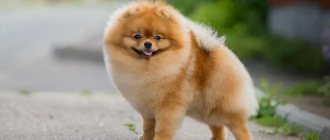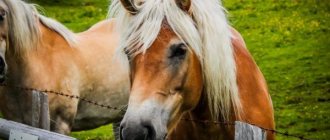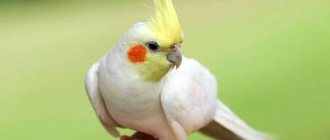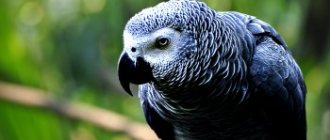What is the life expectancy of guinea pigs? How long do rodents live and what factors influence the timing? Proper care of your pet. How to arrange a rodent's home. Mandatory procedures. Proper nutrition. How to avoid mistakes when caring for a guinea pig.
When we get a pet, we try to provide it with everything it needs to be healthy, happy and live a very long time. Regarding guinea pigs, these domesticated rodents boast a long lifespan compared to others.
Of course, many factors influence their lifespan, but a person can create the right living conditions, provide adequate nutrition, and organize proper care, which will prolong their life.
Next, we will take a closer look at how long guinea pigs live, what affects the duration, how to avoid mistakes in care and maintenance, and how to create favorable conditions for a long life.
average life expectancy
First of all, it is worth saying that these cute animals among all types of rodents are recognized as real long-livers. This factor certainly influenced the enormous popularity of these animals as pets. Nobody wants to buy an animal, get used to it, fall in love with it, and after a short time say goodbye forever.
We can compare the lifespan of another popular pet - hamsters, it is 3-4 years, while guinea pigs live on average 5-8 years.
The funny little animal is considered young, in the prime of life until the age of 4 years, but after 6 years old age sets in. In natural conditions, they encounter a large number of predatory enemies, so they often do not live a long life.
At home, a person creates comfortable and safe conditions, which certainly contributes to a longer life.
As already mentioned, if you create all the necessary conditions for the animal, it will please its owners with good health and a long life, celebrating its 10th anniversary with you.
Rarely, but still there are long-livers who cross the threshold of 12 years. A guinea pig lived in England, which only two months did not live to the age of 15 years and was included in the Guinness Book of Records as a real centenarian.
Factors influencing duration
There are factors that, to one degree or another, can influence the duration, including:
- Guinea pig breed.
- Conditions of detention.
- Care.
- Nutrition.
- Health.
- Heredity.
It is impossible to take into account only some factors and ignore others; each of them requires maximum human attention.
A guinea pig is not a hamster!
guinea pig and hamster
What you might think should be pretty obvious, but many people still mistake guinea pigs for hamsters! Not only do guinea pigs have completely different needs and grow much larger than their very distant relatives, but the lifespan of these creatures also varies. On average, a hamster can live 2-3 years, depending on the breed and lifestyle.
How long does a guinea pig live?
Breed influence
So, this factor, of course, cannot make any adjustments to the deadlines, but it initially determines the set deadlines that the owner can focus on.
We have already said that this representative lives longer than other rodents, and it is also worth saying that some breeds live longer than others.
Breeds that were formed naturally, namely in natural conditions, are more tenacious than those that were bred artificially.
The fact is that when formed in a natural way, the rules of natural selection apply and only the strongest individuals remain.
There are a large number of breeds, there are about 50 of them. Each breed has its own characteristics, they differ in size, color, coat, character and other parameters.
All breeds are divided into groups:
- Short-haired.
- Long-haired.
- Hairless.
The last group, hairless rodents, refers to individuals with the shortest lifespan. The average lifespan is 5 years; with proper maintenance and care, they can live a maximum of 8 years. These animals include the Skinny and Baldwin breeds.
They were bred artificially by breeders and are considered hypoallergenic breeds. Lack of fur certainly leads to frequent colds and illnesses.
Once these breeds were obtained, their life expectancy was the same as that of hamsters, but breeders tried to improve this species as much as possible and managed to extend it.
The owners of the longest life are the short-haired representatives. These little animals live up to 7-8 years and these are average figures.
These breeds include:
- Himalayan.
- American.
- Rex, royal.
- Crested.
- American Teddy
- Texel.
Relatively long-haired, their average life is 6-7 years, but proper care provides longer years.
These representatives include the following breeds:
- Sheltie.
- Peruvian.
- Rosette.
- Coronet.
The figures presented above are only a guideline; you cannot rely on them alone; other factors must be taken into account.
Factors influencing life expectancy
The lifespan of guinea pigs at home is influenced by a whole range of different factors. These include:
- breed of animal;
- content;
- care;
- heredity;
- nutrition;
- health status.
Each of these factors affects the lifespan of guinea pigs to varying degrees, but they should all be taken into account.
Breed influence
Breed affects the life expectancy of an animal less than other factors. This parameter rather allows the pet owner to determine the initially set deadline. Compared to other rodents, pigs live a long time. But representatives of some breeds, according to generalized data, live twice as long as others. Therefore, it is important to know which category your pet belongs to.
Varieties formed naturally (i.e., in natural conditions) are more durable than those bred artificially (by selection). This is due to the fact that natural selection operates in nature - the survival of the fittest.
There are fifty different breeds of guinea pigs in total. They differ in size, color options and other characteristics. They can be divided into three main groups:
- hairless;
- short-haired;
- long-haired.
Hairless or hairless guinea pigs have the shortest lifespan of all varieties. On average, they live 5 years, but with proper maintenance this period can be extended to 8 years (maximum). This category includes the Skinny breed, as well as the equally common Baldwin. These hypoallergenic varieties appeared through the efforts of breeders. They are completely devoid of fur, as a result of which they easily catch colds. Initially, they lived as long as hamsters, but breeders improved the bred variety, thanks to which hairless pigs got a longer life.
Short-haired breeds, on the contrary, have the longest lifespan. On average, these guinea pigs live to be 7–8 years old. These varieties include:
- American;
- American Teddy;
- Himalayan;
- royal, aka Rex;
- crested;
- texel.
Long-haired pigs live on average 6-7 years, but with proper care they can live longer. Breeds included in this category are:
- sheltie, also known as silkie or snare;
- rosette, also known as Abyssinian;
- Peruvian;
- Coronet
When approximately calculating the time allotted to a pet, you cannot focus only on its breed. There are other factors to consider as well.
Conditions of detention
Keeping an animal at home should not be a “prison” in a cage. In order for your pet to live a long life, you need to provide him with a comfortable existence and sufficient physical activity.
The pet's house should be spacious, the desired size is 40x30 cm per animal. The animal's housing needs to be kept clean - regularly cleaned, changed filler and bedding (they should be chosen of high quality).
In addition to the house, the pet should have an area for entertainment, equipped with tunnels and other toys that will allow the animal not to get bored and not become overgrown with excess fat from lack of exercise. From time to time it is worth letting your pet out for a walk and run around a large area - on the street or at least in the rooms of the house.
There should be no drafts in the room where the animal is kept. The air temperature around the pet should be +18–22 °C. Hairless (hairless) pigs need to be kept in an environment with a higher air temperature - the required value is +22–24 °C.
Care
In order for the animal to be healthy and live as long as possible, you need to follow the rules of caring for it. It is necessary to monitor the length of teeth and claws. In order for your pet to grind them down as needed, you need to install a special mineral stone in the cage. Too long teeth will not allow the animal to eat, which will lead to exhaustion and then death. If the pet does not have time to grind down the excess length of the teeth on its own, it will be ground down by a veterinarian. Long claws can be trimmed at home using a nail clipper.
You should regularly check your pet's eyes and ears. If contamination is detected, they must be carefully cleaned. In addition, it is important to take care of your pet’s fur (especially long-haired ones), combing it regularly, preventing it from becoming matted.
You should not bathe the animal often - only when necessary. During and after washing, the animal should be protected from cool air and drafts. It is better to use hypoallergenic shampoo. Bathing water should be warm. After the water procedure, you need to dry your pet's fur with a hairdryer or towel. You cannot leave the fur coat wet - this will lead to hypothermia and the pig will get sick.
Received heredity
This factor cannot be changed; it can only be accepted. If a pet is diagnosed with a genetic disease, all that remains is to love the poor animal as it is. And try to make him happy, despite the illness.
It is believed that diseases transmitted at the genetic level are much less common in short-haired pigs than in hairless and long-haired pigs.
Nutrition composition
The life of an animal is connected with its nutrition. Your little pet should not go hungry. This is due not so much to a lack of nutrients, but to the lack of peristalsis in the pig. The peculiarity of the animal’s body is such that in order for the digested food to be released, the rodent must continue to eat, i.e., only new food can remove processed food from the intestines - each next eaten piece pushes the previous one through the gastrointestinal tract.
You can’t leave him without food, but you shouldn’t overfeed him either. Like all domesticated rodents, domestic guinea pigs are susceptible to obesity.
It is important to create a menu correctly so that your pet receives all the necessary elements in sufficient quantities. Daily nutrition should be shaped so that foods are distributed in the following proportions:
- 60% – high-quality special feed;
- 20% – vegetables and fruits;
- 20% – branches of fruit trees, hay, crackers.
In addition, special mineral and vitamin supplements are necessary for the health of the animal (this is especially true for preparations with vitamin C). We must not forget about drinking; your pet should always have free access to clean, fresh water.
General health
Pigs have strong immunity, but this does not mean that they do not get sick. It is important to monitor any changes in your pet’s behavior and appearance - all this signals a disease.
If any deviations from the pet’s usual condition are detected (for example, the animal itches, coughs, becomes lethargic, shreds fall out of its coat, etc.), you should immediately show the pet to a veterinarian. Diseases are well treated only in the early stages; advanced disease leads to the death of the animal.
It is also worth considering that not all diseases make themselves felt immediately. Therefore, to maintain health, it is better for the animal to be regularly examined by a veterinarian and receive the necessary vaccinations and vaccinations.
Conditions of detention
You can’t just buy a cage, put an animal in it, and think that if you feed it on time, the animal will be completely happy, because this is more like a prison sentence.
Proper content includes a huge number of important points that will make the animal happy and healthy.
First of all, you need to make sure that the cage is spacious, that the necessary accessories are installed in it, and that there is enough free space.
Clean the cage regularly to ensure it is always clean. Change the filler and bedding, wash the tray and all accessories at least once a week. Fillers and fillers must be of high quality.
There must be an equipped area that will allow your favorite animal to have an interesting and fun time. Tunnels and other entertaining toys are installed here.
Remember that in addition to a good mood, they bring health benefits, since they will move more and will not gain excess weight, which happens quite often.
Remember that they should be allowed out of their cage for walks. Let them run around the apartment as often as possible, but ensure complete safety. In warm weather, you can take a walk outside.
The temperature in the room where the animal is kept should be 18-22°. Avoid any drafts, they can get cold very easily.
If you choose a hairless pig, remember that due to the lack of fur, they need a higher room temperature of 22-24°, otherwise they will get sick.
Caring for babies without a nursing mother
If a guinea pig dies during childbirth or abandons her babies, it is very difficult for the babies to come out. The best option is to find them a wet nurse. If you have a pig that has recently given birth, you should try to introduce someone else's litter to it.
The female is more likely to accept cubs that are not her own if she smells a familiar odor coming from them. Therefore, each baby is rolled in stuffing from the foster mother’s cage. The female is placed in a carrier for an hour and a half. Strangers are placed in the nest with the native cubs. After this, the nurse is returned to the cage.
If a nurse cannot be found, the owner of the rodent family will have to care for the brood. The very first thing to do is to protect the little piglets from the cold. A heating pad placed directly in the cage will help with this.
For artificial feeding you will need an insulin syringe without a needle and cream with a fat content of 10%. In the first 3 days after birth, piglets are fed every 2 hours around the clock. On the 4th day, the break between meals is increased to 3 hours. The baby is picked up and held in a column.
Milk is introduced into the mouth very slowly so that the baby does not choke. The initial feeding dose is 0.5-0.7 ml. As the pigs get older, the serving size will increase.
From the 4th day, baby guinea pigs can try new foods:
- carrot;
- apple;
- zucchini;
- dairy-free baby cereals.
Care
Proper care for your guinea pig will not only ensure ideal appearance, good health and well-being, but will also prolong its life. The animal cannot fully take care of itself on its own; it needs human help.
In natural conditions, grinding down of teeth and claws occurs naturally when they get food for themselves and dig holes. At home, in captivity, these processes are absent, so you need to monitor the condition of the teeth and trim the claws.
To grind down their teeth, they are given branches of fruit trees and shrubs, and a special mineral stone is also placed in the cage. If the teeth are too long and problems with nutrition appear, without taking any measures, the rodent will stop eating altogether, which will lead to exhaustion and death. Be sure to undergo examinations by a veterinarian and, if necessary, he will carry out a grinding procedure.
Claw trimming is also carried out regularly. Too long nails prevent you from standing up on your paws normally, interfere with eating and walking, and also lead to curvature of your fingers.
To trim the claws, use a nail clipper; the overgrown part is cut off; you should be careful not to damage the blood vessel that is located inside the nail.
Mandatory procedures include cleaning the ears and examining the eyes. Inspect the ears regularly, if wax is present, using a cotton pad, which is moistened in a special solution and carefully removed.
Also, if there is dirt, the eyes are carefully wiped. It is necessary to monitor the condition of the fur; long-haired dogs should be combed regularly using a special comb and brush.
Regarding bathing, water procedures are not mandatory; it is stressful for the rodent. You should resort to bathing only when absolutely necessary, when the fur cannot be cleaned or the dirt cannot be washed out. If you do bathe your pet, you will need to strictly adhere to the rules of procedure.
You need to buy a special shampoo, before and after bathing, avoid drafts and coolness. After bathing, wrap it in a towel and wait until the fur is completely dry, only then let it go. Some people use a hairdryer to dry the little animal, but not everyone is okay with such a noisy unit.
Differences in the lifespan of pets in nature and at home
Pigs are considered the longest-livers among rodents, their average lifespan is 5-8 years. In nature, under ideal conditions, wild animals can live about 10 years, but their lifespan is negatively affected by diseases, attacks by predators, insufficient or improper nutrition, and adverse weather conditions.
Guinea pigs live longer than any other rodent
The life expectancy of pigs in captivity is shorter due to the selection work carried out on the species: breeders, trying to produce the most beautiful animals possible, did not pay attention to their health. However, the care of the owners, good care, comfortable living conditions, good nutrition and timely medical care help to significantly prolong the life of their beloved pet.
It’s always more comfortable in the company of others like you
Important! Keeping a pig alone reduces life expectancy: without communication and games with relatives, the rodent begins to eat more, move less and may even develop a nervous disorder.
The ideal option is a same-sex couple or a larger number of animals of the same sex. Under no circumstances should you have different-sex animals, because this can lead to disastrous consequences for the health and psyche of both animals.
This is interesting: What is the smallest bird on Earth?
Nutrition composition
A very important component of a healthy life for a guinea pig is nutrition. This animal is forbidden to starve, not because the body needs nutrients, but because these animals lack peristalsis.
This feature is that processed food can leave the intestines only if new food arrives, in other words, a new piece of food pushes through the already processed one.
But you should be very attentive and careful, you cannot leave them hungry, but it is also prohibited to overfeed them, because this can lead to obesity, which is also dangerous for the animal.
Therefore, you need to approach the organization of your diet as responsibly as possible, adhering to the daily nutrition standards:
- 60% is feed.
- 20% - vegetables and fruits.
- 20% - hay, branches of fruit trees, crackers.
We must not forget about vitamins and minerals. The animal must always have clean water.
General health
These animals have a fairly strong immune system; with proper maintenance and care, they can boast of good health. But despite this, rodents, just like others, are susceptible to diseases and it is necessary to monitor any changes in their behavior and appearance.
If you notice any changes, for example, your guinea pig has stopped being active, has lost its appetite, has a cough, it itches a lot, its fur has begun to fall out, and other symptoms, you should immediately go to the veterinarian.
Remember that the disease is easy to treat at an early stage. Advanced disease leads to various severe complications and even death.
Be sure to undergo regular checkups with a veterinarian and get vaccinated. There are diseases that do not show any symptoms in the early stages; examination by a doctor will allow them to be identified in time.
Diseases
Various diseases are a factor that can significantly reduce the life expectancy of any pig. Let's consider the signs by which you can determine the onset of the disease, which will allow you to consult a doctor in time:
- Changes in behavior - lethargy, desire to hide, poor appetite.
- The pig lies in the corner, closes its eyes.
- Heavy breathing, shortness of breath, wheezing, cough.
- The animal began to drink much more often.
- Diarrhea, fur matted on the belly.
- Hair loss.
- Discharge from the nose, eyes.
- Skin ulcers, bald spots.
- Chills, trembling.
- Dry stool, lack of stool.
- Cramps.
- The pig itches frequently.
How to find out age
Of course, it is better to purchase an animal at an early age in order to know exactly in what conditions it grew, how it was kept and what it ate.
But there are situations when they buy adult rodents, in which case it is not possible to determine the exact age, but it is quite possible to recognize a young or older animal.
So, you need to pay attention to the following indicators:
- Activity. It is very difficult for young individuals to sit still, they are interested in absolutely everything around them, they run and fuss. Old age requires peace and quiet; at this age rodents are less active.
- Weight, dimensions. The small animal weighs about 0.5 kg; by the age of 1.5 years, females already weigh 0.7-1.0 kg, and males 1-2 kg. The body length of an adult animal is about 27-29 cm.
- Wool. A young animal's fur is fluffy, soft and very beautiful; with age, small bald patches form; the more of them, the older the rodent. But remember that the condition of the coat is affected by the presence of diseases.
- Teeth. Juveniles have very white, sharp and strong teeth; they can easily handle solid food. Older animals' teeth have a yellow tint; it is more difficult for them to cope with large and hard pieces of food, and their teeth wear down unevenly.
- Claws. You should pay attention to the claws of the hind legs; in young animals they are smooth and well sharpened; in old animals they become crooked and rather blunt.
Table of the age of a rodent by human standards
The rodent's body develops very quickly; 1 year of life for a guinea pig is equivalent to 10-15 years for a human. In the table we can see the relationship between the age of a pet and the age of a person.
| Pig age | 2 weeks | 6 months | 2 years | 5 years | 7 years |
| Person's age | 6 months | 6.5 years | 26 years | 65 years old | 91 years old |
These are approximate indicators; individual parameters should always be taken into account.
How to extend the life of a pet
From the moment an animal appears in a person’s home, all responsibility for its life and health rests with the owner. He needs to create all the conditions for the animal to be happy and healthy; it needs care and love. In fact, it is not that difficult, the main thing is to have the desire.
As already mentioned, the factors that will extend life, proper maintenance, nutrition and care, depend entirely on the person. When organizing meals, you need to remember that they get all the nutrients from food.
The diet should be properly balanced and not contain harmful foods. The older the animal gets, the more attention and care it requires; you need to monitor its health, pay more attention to its teeth and claws.
They are very shy and impressionable, protect them from stress and noise. Avoid drafts and hypothermia. Give them time, don’t let them get bored, play, hold them, talk to them.
In the case when the owner does not have free time, get him a friend, another rodent. Remember that males are competitors and should not be housed together. They will quarrel and even fight for their territory.
Be sure to undergo preventive examinations with a veterinarian. Doctors will prompt and recommend the necessary actions or procedures if a problem is noticed, which will allow it to be eliminated at the initial stage.
Longevity records
With proper and careful care, pigs can live up to ten years. The record holder in terms of longevity are individuals who have lived up to fifteen years. But in ordinary life it is better to forget about records and completely focus on the happiness and health of your animal, then a long life is guaranteed.











